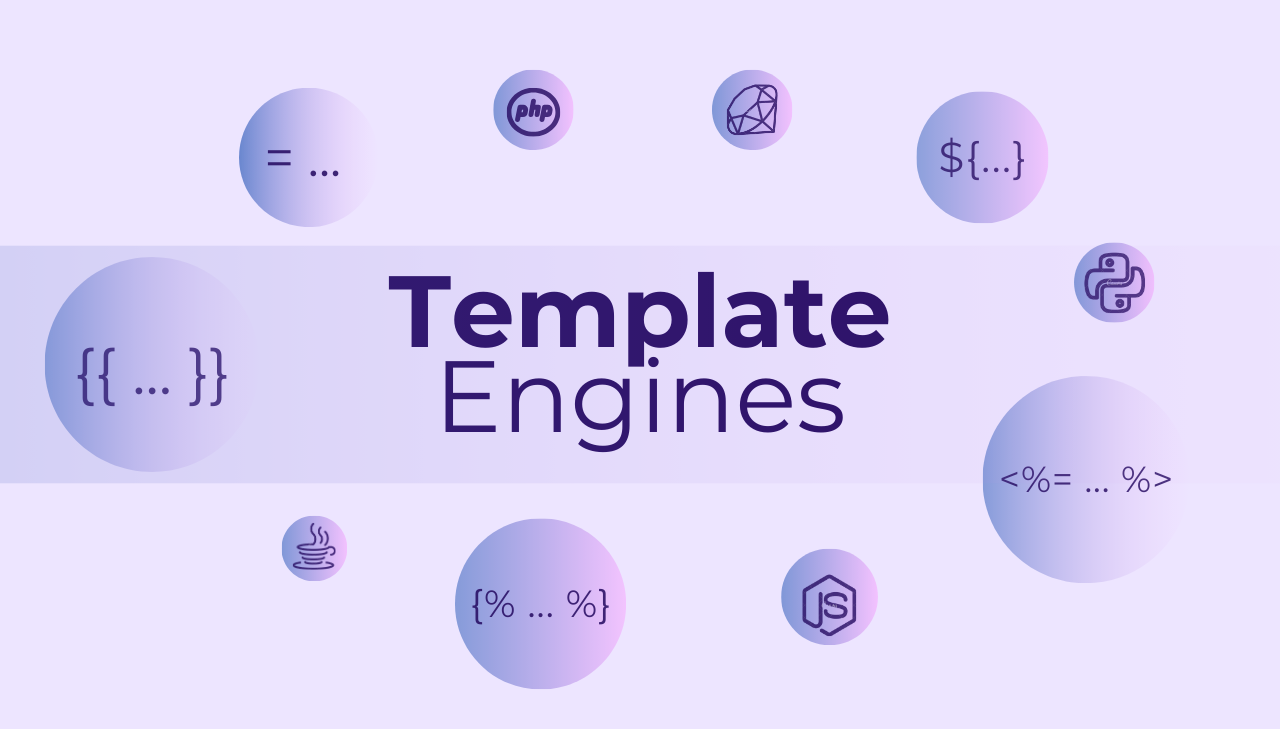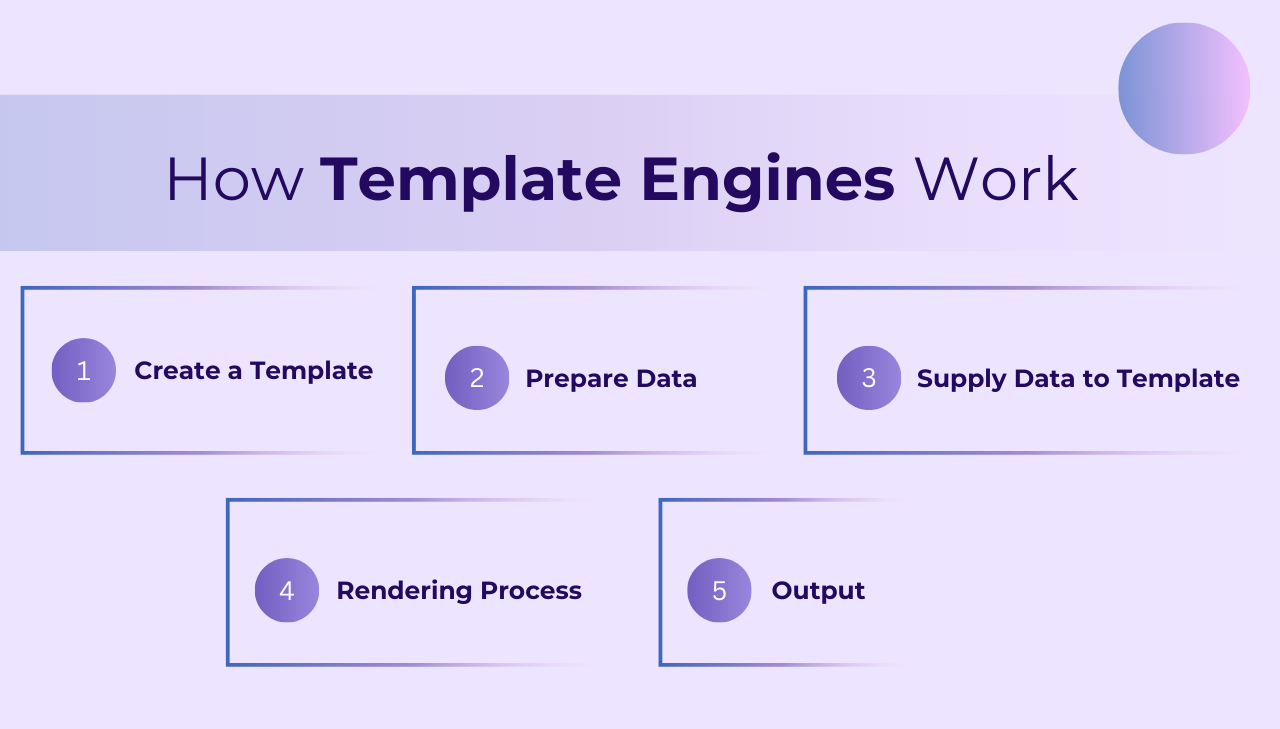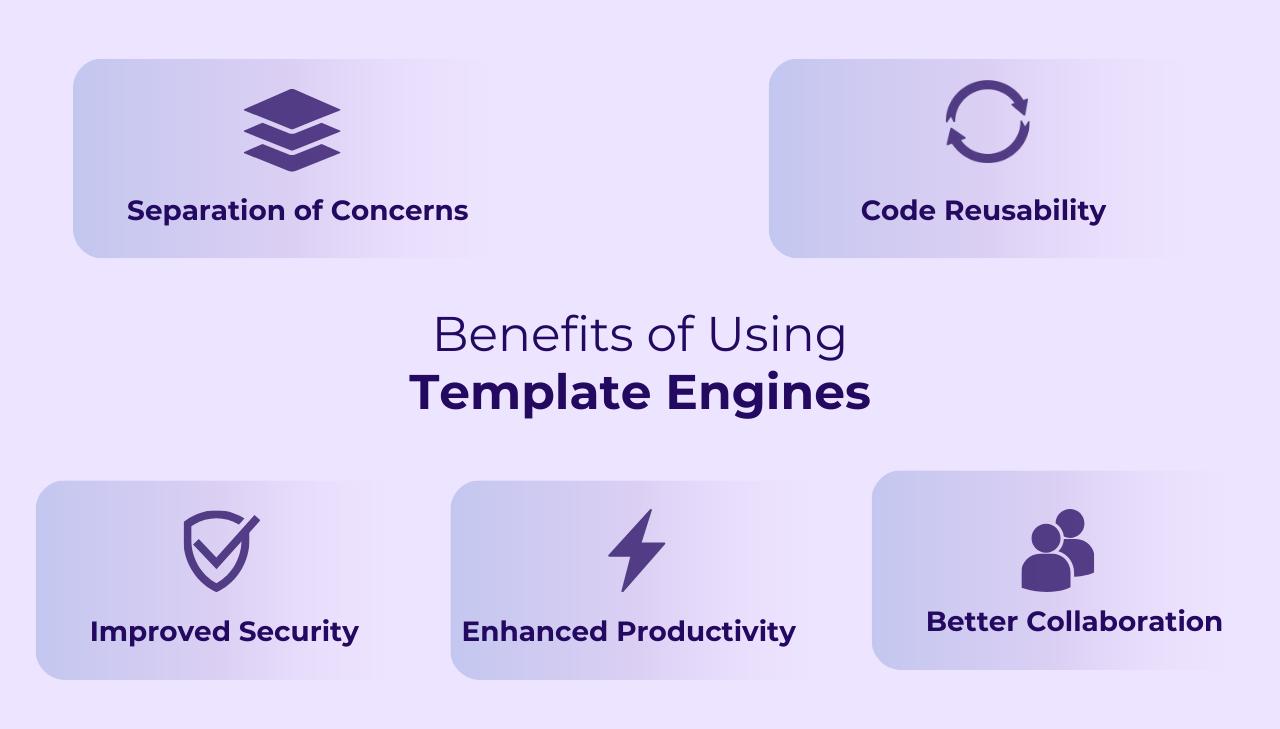Top HTML Template Engines

In the world of modern web development, creating dynamic, data-driven websites efficiently is a constant challenge. Template engines have emerged as a crucial tool in a developer's toolkit, streamlining the process of generating HTML content dynamically. This article explores what template engines are, how they work, their benefits, and the most popular options available today.
Beyond just displaying content on websites, template engines are also valuable for generating consistently formatted HTML documents that can be converted to other formats like PDFs for reports, invoices, contracts, and other business documents. The right template engine can significantly streamline document generation workflows.
What Are Template Engines?
Template engines are software components that allow developers to combine templates (HTML files with special placeholders) with data to generate dynamic web pages. At their core, template engines serve as intermediaries between your data and presentation layers, enabling you to separate business logic from the presentation.
Instead of manually concatenating strings of HTML with data variables, template engines provide a more elegant, readable, and maintainable approach to creating dynamic content.
How Template Engines Work

The basic workflow of a template engine typically involves these steps:
-
Create a template: Developers write HTML markup with special syntax for variables, conditionals, loops, and other programming constructs. These templates serve as reusable blueprints for your pages.
-
Prepare data: Data can come from various sources:
- Database queries.
- API responses.
- User input.
- Configuration files.
- In-memory objects.
This data is typically structured as JSON objects, arrays, or key-value pairs that match the variables expected in your template.
-
Supply data to template: The application passes this structured data to the template engine, establishing the context in which the template will be rendered.
-
Rendering process: The template engine performs several operations:
- Parses the template syntax.
- Identifies placeholders, logic blocks, and expressions.
- Evaluates conditions and loops.
- Replaces variables with their corresponding values from the data.
- Processes any helper functions or filters.
- Output: The final result is a complete HTML document that can be sent to the client's browser or further processed.
For example, here's a simple template using Handlebars syntax:
<html>
<body>
<h1>Hello, {{name}}!</h1>
<ul>
{{#each items}}
<li>{{this}}</li>
{{/each}}
</ul>
</body>
</html>
When this Handlebars template is combined with a data object like:
{
name: "John",
items: ["Apple", "Banana", "Orange"]
}
The rendering process would:
- Replace
{{name}}with "John". - Process the
{{#each items}}loop to iterate through the array. - For each iteration, replace
{{this}}with the current array item.
The final rendered HTML would be:
<html>
<body>
<h1>Hello, John!</h1>
<ul>
<li>Apple</li>
<li>Banana</li>
<li>Orange</li>
</ul>
</body>
</html>
Benefits of Using Template Engines

I recently came across an interesting question on Reddit, where a developer asked: "Why do we need template engines exactly?"
Let's address this fundamental question and explore the specific benefits in detail:
1. Separation of Concerns
Template engines enforce the separation of business logic from presentation logic, making your code more maintainable and easier to understand. This separation aligns with the MVC (Model-View-Controller) pattern, a cornerstone of modern web development.
2. Code Reusability
Most template engines support partials or includes, allowing you to define reusable components once and include them across multiple pages. This drastically reduces duplication and makes maintenance simpler.
3. Improved Security
Template engines often include built-in security features like automatic HTML escaping, which helps prevent cross-site scripting (XSS) attacks by default.
4. Enhanced Productivity
With features like inheritance, partials, helpers, and filters, template engines make it faster to develop complex layouts and interfaces. They provide shorthand methods for common operations, reducing the amount of code you need to write.
5. Better Collaboration
The separation of HTML templates from application code makes it easier for designers and developers to collaborate without stepping on each other's toes.
Common Use Cases for Template Engines
Template engines excel in numerous scenarios:
Dynamic Web Content
Most commonly, template engines power dynamic websites and web applications by injecting data into reusable layouts.Document Generation
Template engines are perfect for creating structured HTML documents that can be converted to PDFs for:- Business reports and analytics dashboards.
- Invoices, receipts, and financial statements.
- Contracts and legal documents.
- Marketing materials and product catalogs.
- Certificates and personalized documents.
The clean separation of data and presentation makes template engines ideal for generating professional documents at scale.
Email Templates
Marketing and transactional emails benefit from template engines' ability to personalize content while maintaining brand consistency.Now, let's explore the most popular template engines across different programming languages.
Cross-Language Template Engines
While many template engines are designed for specific programming languages, some engines are available across multiple languages, offering consistent syntax and functionality regardless of your backend technology.
1. Mustache
Mustache is a logic-less template system with implementations in an impressive number of programming languages, making it an excellent choice for polyglot development teams.
Key features:
- Truly logic-less templates.
- Consistent syntax across all languages.
- Focus on simplicity and minimal logic.
- Great for teams working with multiple programming languages.
Implementations across languages:
- JavaScript: Mustache.js
- Java: Mustache.java and JMustache
- PHP: Mustache.php
- Python: Pystache and chevron
- Ruby: Mustache
- Rust: Rustache
- Go: Mustache
- C#/.NET: Stubble
Example syntax:
<h1>{{title}}</h1>
<ul>
{{#users}}
<li>{{name}}</li>
{{/users}}
</ul>
2. Handlebars
While Handlebars started in JavaScript, its syntax and approach have inspired implementations across many languages.
Key features:
- Extends Mustache with more powerful features.
- Consistent syntax across language implementations.
- Familiar syntax for developers switching between languages.
- Widely adopted across programming languages.
Implementations across languages:
- JavaScript: Handlebars.js
- Java: Handlebars.java
- C#/.NET: Handlebars.Net
- Rust: Handlebars-rust
- Go: Raymond
Example syntax:
<h1>{{title}}</h1>
<ul>
{{#each users}}
<li>{{this.name}}</li>
{{/each}}
</ul>
3. Liquid
Liquid was originally created by Shopify for Ruby but has since been ported to numerous languages while maintaining its approachable syntax.
Key features:
- Secure by design (no arbitrary code execution).
- Balance between logic-less and programming capabilities.
- Used in e-commerce platforms like Shopify.
- Excellent documentation.
Implementations across languages:
- Ruby: Original Liquid (by Shopify)
- JavaScript/Node.js: LiquidJS
- PHP: PHP-Liquid
- .NET/C#: DotLiquid
- Python: python-liquid
- Java: Liqp
- Go: liquid
Example syntax:
<h1>{{ title }}</h1>
<ul>
{% for user in users %}
<li>{{ user.name }}</li>
{% endfor %}
</ul>
JavaScript and Node.js Template Engines
JavaScript has a rich ecosystem of template engines, catering to both browser and server-side rendering needs with Node.js.
1. Pug (formerly Jade)
Pug offers a concise syntax that significantly reduces the amount of template code through indentation-based nesting and shorthand notations.
Key features:
- Whitespace-sensitive syntax.
- Mixins for reusable blocks.
- Includes and extends for template inheritance.
- Filters for inline processing.
- Rich expression support.
Example syntax:
h1= title
ul
each user in users
li= user.name
2. EJS (Embedded JavaScript)
EJS provides a simple way to embed JavaScript code directly within HTML templates. It's lightweight and straightforward, making it a popular choice for Node.js applications.
Key features:
- Fast compilation and rendering.
- Simple syntax with familiar JavaScript code.
- Client-side and server-side support.
- Includes, partials, and layouts.
- Works with Express.js out of the box.
Example syntax:
<h1><%= title %></h1>
<ul>
<% users.forEach(function(user){ %>
<li><%= user.name %></li>
<% }); %>
</ul>
3. Nunjucks
Nunjucks is a powerful templating engine for JavaScript inspired by Jinja2, developed by Mozilla. It offers rich features while maintaining a clean, readable syntax.
Key features:
- Powerful template inheritance system.
- Rich set of built-in filters.
- Asynchronous control when needed.
- Macros for reusable template fragments.
- Autoescaping for security.
- Extensibility through custom filters and extensions.
Example syntax:
<h1>{{ title }}</h1>
<ul>
{% for user in users %}
<li>{{ user.name }}</li>
{% endfor %}
</ul>
Python Template Engines
Python has several powerful template engines, with different approaches to syntax and functionality.
1. Jinja2
Jinja2 is the most widely used template engine in the Python ecosystem, powering Flask and many other frameworks.
Key features:
- Expressive language with Python-like syntax.
- Template inheritance.
- Automatic HTML escaping.
- Rich filters and tests.
- Sandboxed execution.
Example syntax:
<h1>{{ title }}</h1>
<ul>
{% for user in users %}
<li>{{ user.name }}</li>
{% endfor %}
</ul>
2. Django Templates
Django Templates is Django's built-in template system that provides a secure and flexible way to generate HTML content in Django applications.
Key features:
- Simple and restrictive syntax by design.
- Template inheritance.
- Automatic HTML escaping.
- Custom template tags and filters.
- Integration with Django's ORM.
Example syntax:
<h1>{{ title }}</h1>
<ul>
{% for user in users %}
<li>{{ user.name }}</li>
{% endfor %}
</ul>
3. Mako
Mako is a high-performance template library that supports embedded Python code within templates.
Key features:
- Python-like syntax with full Python expressions.
- Template inheritance.
- Reusable components with defs.
- High performance.
- Text filters.
Example syntax:
<h1>${title}</h1>
<ul>
% for user in users:
<li>${user.name}</li>
% endfor
</ul>
Java Template Engines
Java offers several mature template engines, each with unique strengths for enterprise applications.
1. Thymeleaf
Thymeleaf is a modern server-side template engine for Java applications, particularly well-suited for Spring MVC.
Key features:
- Natural templates that display correctly in browsers.
- Integration with Spring.
- Dialect extensibility.
- Layout system.
- Fragment inclusion.
Example syntax:
<h1 th:text="${title}">Default Title</h1>
<ul>
<li th:each="user : ${users}" th:text="${user.name}">User Name</li>
</ul>
2. FreeMarker
FreeMarker is a versatile template engine focused on generating text output based on templates.
Key features:
- Powerful template language.
- Macros and functions.
- Template inheritance.
- No external dependencies.
- High performance.
Example syntax:
<h1>${title}</h1>
<ul>
<#list users as user>
<li>${user.name}</li>
</#list>
</ul>
3. Velocity
Velocity is a mature template engine that has been part of the Java ecosystem for decades.
Key features:
- Simple and intuitive syntax.
- Reference notation for accessing Java objects.
- Macros for reusable template code.
- Directives for control flow.
- Extensible.
Example syntax:
<h1>$title</h1>
<ul>
#foreach($user in $users)
<li>$user.name</li>
#end
</ul>
PHP Template Engines
PHP has evolved from being a template language itself to offering sophisticated template engines.
1. Blade (Laravel)
Blade is the templating engine used by the Laravel framework, offering an expressive, elegant syntax.
Key features:
- Template inheritance.
- Sections and components.
- Directives for control structures.
- Template caching.
- Easy integration with Laravel's ecosystem.
Example syntax:
<h1>{{ $title }}</h1>
<ul>
@foreach($users as $user)
<li>{{ $user->name }}</li>
@endforeach
</ul>
2. Twig
Twig is a flexible, fast, and secure template engine for PHP, used by Symfony and many other frameworks.
Key features:
- Expressive syntax.
- Template inheritance.
- Automatic HTML escaping.
- Extensible with custom filters and functions.
- Sandbox mode for added security.
Example syntax:
<h1>{{ title }}</h1>
<ul>
{% for user in users %}
<li>{{ user.name }}</li>
{% endfor %}
</ul>
3. Smarty
Smarty is one of the oldest and most established PHP template engines, focusing on separating PHP from HTML.
Key features:
- Variable modifiers.
- Caching system.
- Template inheritance.
- Custom functions and modifiers.
- Plugin architecture.
Example syntax:
<h1>{$title}</h1>
<ul>
{foreach $users as $user}
<li>{$user.name}</li>
{/foreach}
</ul>
Ruby Template Engines
Ruby offers several template engines, with ERB and Haml being the most widely used in Rails applications.
1. ERB (Embedded Ruby)
ERB is Ruby's standard library template system and is the default for Ruby on Rails.
Key features:
- Embedded Ruby code in HTML.
- Simple and straightforward.
- No additional dependencies.
- Fast processing.
- Tight integration with Rails.
Example syntax:
<h1><%= title %></h1>
<ul>
<% users.each do |user| %>
<li><%= user.name %></li>
<% end %>
</ul>
2. Haml
Haml is a markup language that's designed to avoid writing inline code in HTML and reduce template size.
Key features:
- Clean, indentation-based syntax.
- Reduces markup by eliminating closing tags.
- Ruby code evaluation.
- HTML generation.
- CSS-like ID and class declaration.
Example syntax:
%h1= title
%ul
- users.each do |user|
%li= user.name
3. Slim
Slim is a lightweight template engine that aims to reduce syntax to the essential parts without losing flexibility.
Key features:
- Minimal syntax.
- Speed and performance.
- Safety with automatic HTML escaping.
- Logic less mode.
- Configurable shortcut tags.
Example syntax:
h1 = title
ul
- users.each do |user|
li = user.name
Choosing the Right Template Engine
For a comprehensive list of template engines across various programming languages, check out the Awesome Template Engine repository on GitHub.
When selecting a template engine for your project, consider these factors:
- Language compatibility - Choose an engine that works well with your programming language and framework.
- Performance - Consider rendering speed and memory usage.
- Learning curve - Evaluate the syntax complexity and documentation quality.
- Community support - Look for active development and community resources.
- Features - Assess whether it provides the functionality your project needs.
- Security - Check for built-in protection against common vulnerabilities.
- Output quality - If you'll be converting HTML to PDF or other formats, consider how well the template engine handles precise layouts, page breaks, and print-specific CSS.
- Styling capabilities - Evaluate support for CSS frameworks and custom styling that will translate well to other document formats.
Conclusion
Template engines are essential tools in modern web development, providing structure, reusability, and separation of concerns. Each programming language offers multiple template engine options with different strengths and approaches.
Whether you prefer the simplicity of EJS, the elegance of Jinja2, the natural templates of Thymeleaf, the expressiveness of Blade, or the minimalism of Slim choosing the right template engine can significantly impact your development experience and application architecture.
For developers working with document generation workflows, template engines provide essential structure and consistency when creating HTML that will be converted to PDFs or other document formats. The right template engine can dramatically simplify creating professional, data-driven documents at scale while maintaining precise control over the final output.
By understanding the features, syntax, and benefits of each template engine, you can make an informed decision that aligns with your project requirements and team preferences.
May your templates compile and your variables interpolate – nobody likes seeing {{ name }} on their document! 😉
